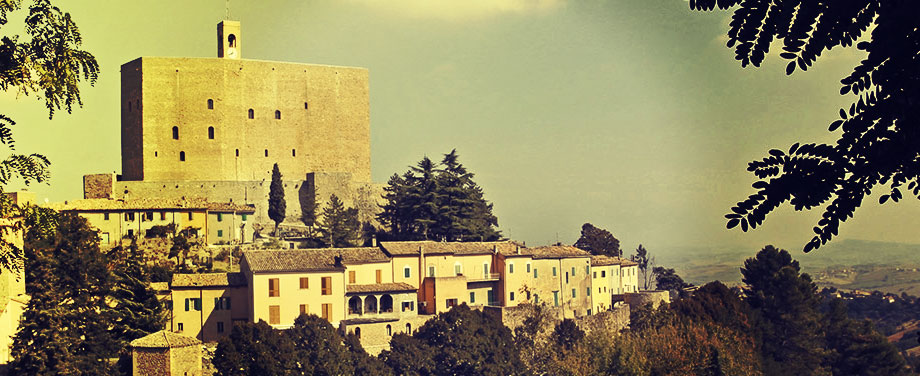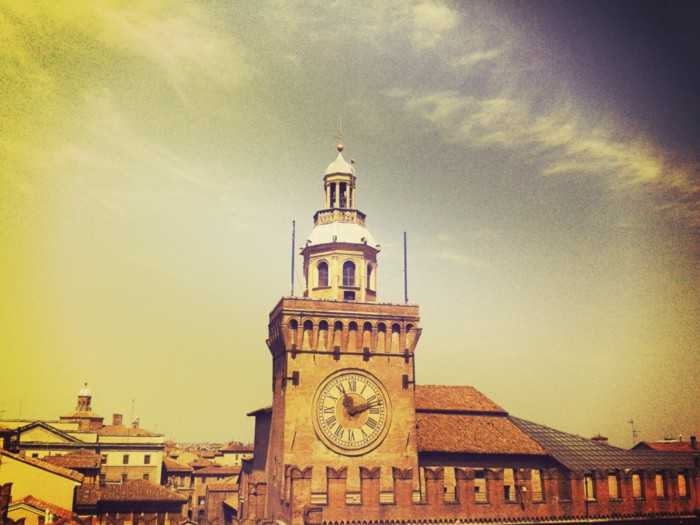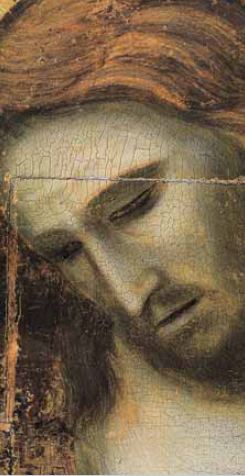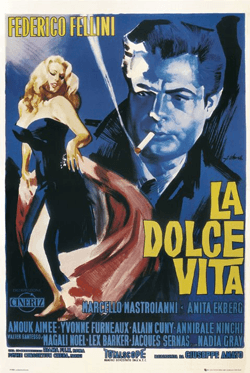Tuscany’s success in presenting itself as the ideal Italian destination is legendary. To the British it’s affectionately known as ‘chiantishire’, while for thousands of American and European readers it is linked indelibly with the romantic vision presented by Frances Mayes in Under a Tuscan Sun. The irony of it all is that the very things that visitors crave in Tuscany – a personal encounter with history, the peace and quiet of a small Italian town, the value given to tradition and quality, the chance to see extraordinary art and culture up close – are increasingly difficult to find there as the region becomes ever-more swamped by coachloads of tourists who more often than not encounter inflated prices and resentful locals. For years now various Italian regions have been signalled by travel writers and tourists alike, as the ‘New Tuscany’ – most noticeably the nearby regions of the Marche and Umbria. The funny thing is that the most obvious contender for the title, Emilia-Romagna, has rarely been mentioned. Perhaps it’s because of the rivalry between the two zones that this wonderful region on the Adriatic coast has been slow to present itself in this light (after all, why should it lower itself to be the ‘new’ anything, when it has such a rich culture and tradition of its own); Perhaps it’s because much of this region flourishes outside of the tourism sector – the region produces a staggering amount of Italy’s best known foods and luxury products. Perhaps it’s simply because they can’t see what’s in front of their own eyes. Whatever the reason, we at TMOTravel have taken it upon ourselves to draw up a simple 5 point list to prove that Emilia-Romagna has all that anyone could look for in the ‘new Tuscany’ .
 Part of the appeal of Tuscany is without doubt its beautiful hilltop towns that dot the countryside – brilliantly preserved examples of historic architecture like San Giminiano or the wine-cultivating town of Montepulciano It should be of little surprise, though, that Emilia Romagna – and in particular the lower Romagnolo half of the region has any number of similarly aged and beautifully preserved towns – given that the region, more than any other, shares a similar history and geography with Tuscany. For example, while the province of Rimini is usualy most associated with its beach resorts on the Adriatic Riviera, driving inland amongst the hills of the Conca and Marecchia river valleys you’ll find any number of historic towns with castles and churches dating back to the early middle ages: towns like Verucchio – the birthplace of the Malatesta dynasty whose magnificent medieval fortress the Rocca Malatestiana still dominates the town (and which nowadays also plays host to a prestigious annual international music festival ); or the walled town of Montefiore Conca which dates back to at least the 12th Century and which has won the Touring Club of Italy’s Banda Arancione (orange flag), an award recognising excellence in tourism and conservation (it’s also regularly listed amongst Italy’s most beautiful towns); or the famous impenetrable fortress town of San Leo, where the pope imprisoned the notorious Caliogstro (the town also boasts two beautiful churches, of which the 8th Century Romanesque church – recently restored – is particularly haunting and impressive). That’s just to name but a few towns in the province of Rimini. Travel further north towards and into Emilia and you’ll find beautiful and historically important towns like Canossa (where the Emporor Henry IV famously knelt in the snow to beg forgiveness from Pope Gregory VII during the first great clash between Empire and Papacy); or Dozza, not far from Bologna, famous for its murals; or Brisighella a renowned stop on the pilgrimage route, the Via Romei, for the devout travelling from Northern Europe down to Rome over the centuries – which in modern times has become famous for its annual medieval re-enactment festival (should we mention that it too is listed in Italy’s most beautiful towns, and has the banda arancione?)
Part of the appeal of Tuscany is without doubt its beautiful hilltop towns that dot the countryside – brilliantly preserved examples of historic architecture like San Giminiano or the wine-cultivating town of Montepulciano It should be of little surprise, though, that Emilia Romagna – and in particular the lower Romagnolo half of the region has any number of similarly aged and beautifully preserved towns – given that the region, more than any other, shares a similar history and geography with Tuscany. For example, while the province of Rimini is usualy most associated with its beach resorts on the Adriatic Riviera, driving inland amongst the hills of the Conca and Marecchia river valleys you’ll find any number of historic towns with castles and churches dating back to the early middle ages: towns like Verucchio – the birthplace of the Malatesta dynasty whose magnificent medieval fortress the Rocca Malatestiana still dominates the town (and which nowadays also plays host to a prestigious annual international music festival ); or the walled town of Montefiore Conca which dates back to at least the 12th Century and which has won the Touring Club of Italy’s Banda Arancione (orange flag), an award recognising excellence in tourism and conservation (it’s also regularly listed amongst Italy’s most beautiful towns); or the famous impenetrable fortress town of San Leo, where the pope imprisoned the notorious Caliogstro (the town also boasts two beautiful churches, of which the 8th Century Romanesque church – recently restored – is particularly haunting and impressive). That’s just to name but a few towns in the province of Rimini. Travel further north towards and into Emilia and you’ll find beautiful and historically important towns like Canossa (where the Emporor Henry IV famously knelt in the snow to beg forgiveness from Pope Gregory VII during the first great clash between Empire and Papacy); or Dozza, not far from Bologna, famous for its murals; or Brisighella a renowned stop on the pilgrimage route, the Via Romei, for the devout travelling from Northern Europe down to Rome over the centuries – which in modern times has become famous for its annual medieval re-enactment festival (should we mention that it too is listed in Italy’s most beautiful towns, and has the banda arancione?)
One of the attractions for a traveller to Tuscany is that they can take in a number of famous historic cities without having to travel huge distances – Florence, Sienna, Lucca and Pisa for example. This is equally true of Emilia-Romagna, with cities like Bologna, Modena, Parma, Ravenna, and Ferrara all clustered within easy reach. In fact, Emilia-Romagna probably has the upper hand here because for travellers without a car the public transport links between all these cities are good (and cheap). Anyone who’s ever attempted to travel from Florence to Sienna by public transport will know what I mean here.

Let’s give you a quick introduction: Bologna: The regional capital is known alternatively as la dotta (the learned) because it has the world’s oldest university; la grassa (the fat) because it’s widely regarded as the gastronomic capital of Italy; and la rossa (the red) because it’s one of Italy’s most active left-wing cities. The common reaction of visitors to the city is ‘I never realised Bologna was so beautiful!’. Ferrara: Ferrara is a small and pleasant provincial city (population 130,000) which has an unbelievable heritage as shown by its huge moated Castle and impressive Cattedrale di San Giorgio. This town was the stronghold of the important Este family, and an important seat of power in the middle ages. Its annual Buskers festival is a highlight, though in truth this pedestrian friendly city is great to visit anytime. Ravenna: Ravenna has in its past been a seat of the Holy Roman Empire, the capital of the Kingdom of the Ostrogoths, and one of the most important Bishoprics in italy. Little wonder then that it boasts 8 UNESCO world heritage sites. Modena: Modena, the home town of the late Pavarotti, has a magnificent central piazza and duomo, both listed by UNESCO, which make the city a must on any trip to northern Italy. Parma: Its fame throughout Europe is linked directly to its quality food – cured hams and one of the world’s favourite cheeses, but this city is also one of Northern Italy’s ‘Citta d’Arte’, and boasts an impressive cultural heritage. And of course there’s Rimini , with its Roman roots (it was founded by the Romans as the city called Ariminum), it’s medieval past (the Malatesta Castel Sismondo is at the town’s centre), and its world-famous beachfront witness to the post-war Italian economic miracle.
 Look, let’s be honest here, there’s no single collection in Emilia-Romagna that can match Florence’s Uffizi gallery. But, and this is a big but, at least the world-class art you’ll find in Emilia-Romagna is easily accessible. You won’t find yourself having to queue in the blistering sun for hours, and you won’t have to spend a fortune either – in fact, many of Emilia-Romagna’s most beautiful artefacts are open to the public for free. The artistic patrimony of the region is too vast to go into in any detail here, but let’s point out the beautifully preserved early-christian mosaics of Ravenna; the works of Giotto, Raffaello, Parmigianino, Carracci, Guido Reni in Bologna’s Pinacoteca Nazionale; Rimini’s Tempio Malatestiano, credited by many as the birthplace of renaissance architecture – and the magnificent crucifix by Giotto housed within; Reggio Emilia’s Baroque Basilica della Ghiara; and Modena’s Lanfranc designed Romanesque Duomo. To get a better idea of the visual art on offer, we’d encourage you to check out the Emilia-Romagna Città d’Arte website and it’s virtual tour. Of course, closer to the present day Emilia-Romagna has had a huge impact on modern day Italian culture, from the films of Federico Fellini, through to the music of artists like Francesco Guccini, Lucio Dalla, Gianni Morandi, and Ligabue, alongside the novels of Carlo Lucarelli (the acknowledged master of Italian noir, or Pier Vittorio Tondelli (one of Italy’s great transgressive authors).
Look, let’s be honest here, there’s no single collection in Emilia-Romagna that can match Florence’s Uffizi gallery. But, and this is a big but, at least the world-class art you’ll find in Emilia-Romagna is easily accessible. You won’t find yourself having to queue in the blistering sun for hours, and you won’t have to spend a fortune either – in fact, many of Emilia-Romagna’s most beautiful artefacts are open to the public for free. The artistic patrimony of the region is too vast to go into in any detail here, but let’s point out the beautifully preserved early-christian mosaics of Ravenna; the works of Giotto, Raffaello, Parmigianino, Carracci, Guido Reni in Bologna’s Pinacoteca Nazionale; Rimini’s Tempio Malatestiano, credited by many as the birthplace of renaissance architecture – and the magnificent crucifix by Giotto housed within; Reggio Emilia’s Baroque Basilica della Ghiara; and Modena’s Lanfranc designed Romanesque Duomo. To get a better idea of the visual art on offer, we’d encourage you to check out the Emilia-Romagna Città d’Arte website and it’s virtual tour. Of course, closer to the present day Emilia-Romagna has had a huge impact on modern day Italian culture, from the films of Federico Fellini, through to the music of artists like Francesco Guccini, Lucio Dalla, Gianni Morandi, and Ligabue, alongside the novels of Carlo Lucarelli (the acknowledged master of Italian noir, or Pier Vittorio Tondelli (one of Italy’s great transgressive authors).
This list is not in strict order – an important point to make, as many of our friends here in Emilia-Romagna would be shocked otherwise with the position of food and drink in this list, given its centrality to life in the region. There may be a couple of places in Tuscany where you can eat as well as in Emilia-Romagna, but there are none where you can eat better!
There are also a myriad of ways that you can combine gastronomy with your trip, learning about the traditions and practices that have made this region’s produce famous worldwide. For example, you can take a trip to Modena to see where the famous Balsamic vinegar is made (which can cost up to €150 a bottle in the shops). In many of the vineyards they also make the bubbly red Lambrusco. Or you can take the Wine Road in Romagna organised by the small producers association Strada dei Vini e dei Sapori dei Colli di Rimini, which gives you an itinerary to travel amongst the hills of Romagna sampling typical products like wines, cheeses, honey, cured meats, and local breads while at the same time giving you an idea of the history and culture that has produced them. Emilia-Romagna also gave birth to an interesting association, the Cesarine, who promote home-food-cooking. If you’re looking for an authentic italian home-prepared meal this is the place for you. The association holds special events where you, as a guest (you must sign up to become a member first), can go to the home of one of their members to eat a special and truly authentic Italian meal. If all this sounds a tad organised, you can just enjoy a meal in any of the regions fine restaurants. Specialities differ from town to town, from the famous Talgiatelle Bolognese in Bologna, to Rimini’s humble (but magnificent) Piadina bread, from Modena’s cotechino in galera through to Ferrara’s famous roast pumpkins (Zucca al forno), the riviera’s wonderful fresh seafood, through to the meats and vegetarian specialities of the hills – there’s something for everyone on this region’s menu. And any Italian region that prides itself on the quality of its food has, obviously, the wines to go with it. If you’re a wine lover you’ll have a ball travelling through the region sampling wines like the red Sangiovese (the classic Tuscan chianti, it’s worth pointing out, is made primarily from the Sangiovese grape – about 70%), the famous white Albana di Romagna, the under-rated fizzy Lambrusco, or any of the numerous local wines produced in the hills (colli) outside the cities like Rimini, Bologna, Parma, and Faenza to name but a few.
 5) La Dolce Vita
5) La Dolce VitaUndoubtedly one of the reasons that visitors come to Italy is to sample its famous dolce vita, to breathe in that famous relaxed atmosphere where art, food, weather, and community all blend together to produce a different and attractive approach to life. One reason Tuscany has been so successful in attracting visitors is that it serves up all these factors of Italian life in an attractively easy bite. It’s easy to get to Tuscany, and when you’re there it has a great infrastructure. There are plenty of other magnificent and beautiful regions of Italy, where arguably you get a more ‘authentic’ slice of Italian life – for example Southern regions like Calabria, and Puglia – but they’re beset with difficulties for the average tourist. They’re not easy to get to, and when you do get there often the infrastructure, whether it be hotel facilities or public transport, leaves something to be desired. They are, in short, anything but easy, and it’s not easy to sample la dolce vita if your tired with frayed nerves! You can arrive easily in Emilia-Romagna with its various international airports (Bologna, Forli, Rimini, and Parma) linked to an increasing offer of low-cost carriers, its high speed rail connections (it takes just 65 minutes to reach Bologna from Milan – over 210km away), and fine motorways. Getting around between the various cities in the region is a cinch because of this infrastructure. In one weekend you can sample a huge spectrum of Italian life. Let’s take an example – you fly in to Rimini on a Friday morning (The Federico Fellini international airport has a wide range of flights from around Europe). You take your choice between heading to the beach, checking out the historic town centre with its Roman and Medieval monuments, or even perhaps following Fellini’s footsteps around the town. For lunch you sit back and enjoy a chilled white trebbiano with a plate of fresh seafood cooked as only the Italians know-how. In the afternoon you can enjoy a trip into the hills to the fortress town of San Leo (where the mysterious Count Cagliostro, reputed alchemist and expert of the Kabbalah,was imprisoned by the Pope), or perhaps to the world’s oldest surviving Republic San Marino (visible from Rimini), and be back in time for an apperitivo and meal before sampling the world famous Rimini nightlife. Saturday morning you can head to the regional capital Bologna – just over an hour away, fortified perhaps by a decent espresso, and wander around its distinctive porticoed streets soaking up the atmosphere (Bologna has been the setting of countless novels, nearly all of them noir in style), before eating a hearty lunch of famous tagliatelle bolognese. Saturday afternoon you can do some serious shopping – you can find all the big Italian designers here (no need to head to the distinctly less charming Milan), or if you’re budget doesn’t stretch that far you can head to the montagnola market (like many Italians do) for top quality clothes, shoes and bags, at rock-bottom prices. For the evening, you could take a short train ride (20 mins) to the charming town of Ferrara, and settle into one of its numerous osterie for some great food. If you plan ahead you could be there for its Buskers festival, when the city comes alive with music on every corner – or the Internazionale magazine festival which attracts world class journalists and writers like Noam Chomsky, Roberto Savviano, Misha Gleny, and Tim Parks (to name but a few). Sunday is a relaxing day, but you still want to see things, so head to Modena in the morning for a stroll around town – it’s just a half-an-hour outside Bologna, and has a very small and easy to navigate city centre, dominated by one of the most beautiful piazzas in Italy! Sunday afternoon in Italy is ruled by sport, and in Emilia-Romagna you are spoilt for choice. You can head back to Bologna and catch a Serie A game in the impressive Renato dall’Ara stadium (one of the finest examples of fascist architecture you’ll find); You can head to the home of Ferrari, just outside Modena, where there is a dedicated museum to the famous sports car – in fact, if sports cars are your thing, you can do a tour of the region’s most famous factories, Ferrari, Lamborghini, and Maserati (not forgetting Ducati motorbikes in Bologna). And all in time to get you back for a return flight on Sunday evening. And that’s just one itinerary out of many, that include great food, art, architecture, sport, and nature. If you want to step into la dolce vita, there’s no easier entry-point than Emilia-Romagna